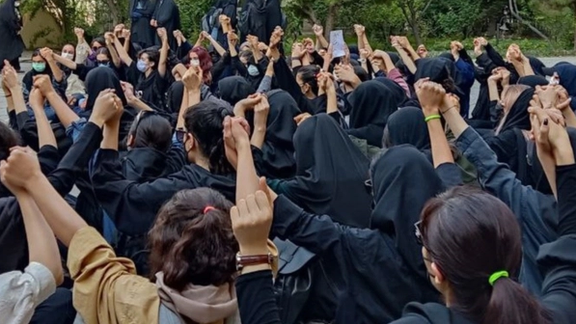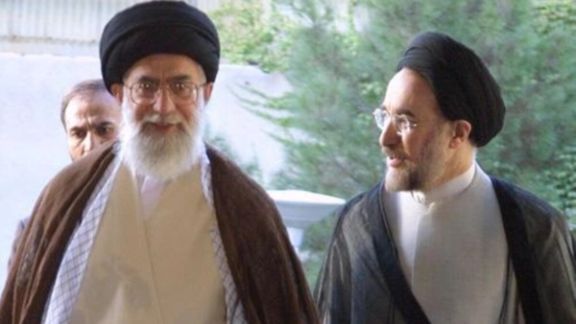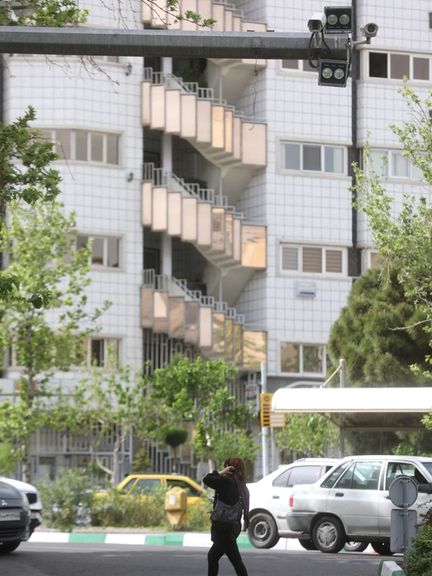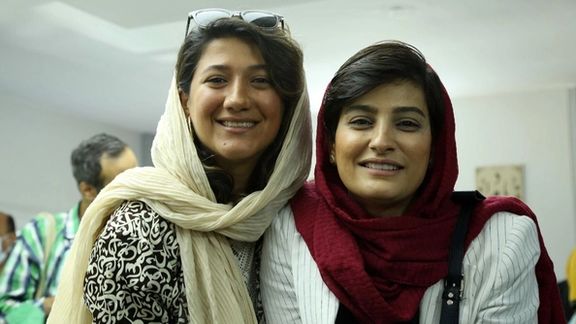Nearly 150 Students Denied Right to Study During Iranian Uprising

At least 147 students from 43 universities were barred from studying during the Iranian uprising, according to a recent study.

At least 147 students from 43 universities were barred from studying during the Iranian uprising, according to a recent study.
Following the Woman, Life, Freedom protests, the Committee to Follow Up on the Status of Detainees launched a special project to document and monitor repressive actions within the country's universities. It is the first such initiative to have officially gathered information on students who were expelled or faced bans from studying for several semesters.
The many disciplinary actions had not been made public until now, though the numbers are only the tip of the iceberg, the true extent believed to be far higher than those made public.
The regime's security forces sought to control the wave of protests which began in September after the death in police custody of Mahsa Amini, by targeting universities, assaulting students, carrying out kidnappings and arrests in campuses across the country.
In May, Iran International reported that eight students had been deprived of education for up to two years or exiled to other cities as punishment for protesting a wave of chemical attacks in Iran's universities and schools which lasted several months.
In April, Iran’s Student Union Council claimed that more than 430 students had been suspended or expelled following the recent protests across the country “through an illegal process,” as reported by Iran International at the time.
At the time, US-based Human Rights Activists News Agency (HRANA) said 637 students from 144 universities had been arrested since mid-September. Other sources which have put the number at well over 700.
The official report claims the most common disciplinary measures include "one-semester suspension," affecting 64 protesting students, followed by "two-semester suspension," which impacted 52 students.
Tabriz University of Medical Sciences, Tehran University, and Allameh Tabatabai are among the universities with the highest number of disciplinary orders against their students, the report claims.

On Monday night, Iranian security forces used tear gas to disperse a protest in Divandarreh.
The demonstration was in response to several days of water cuts that have left residents without access to drinking water. According to reports from Hengaw human rights organization, at least four protesters were injured during the crackdown.
The protest emerged after a group of people from the Kurdish city took to the streets to voice their frustration over the continuous water shortages.
Videos of the protests circulating online depict the security forces firing tear gas in an attempt to confront the demonstrators.
Divandarreh has been grappling with frequent and widespread drinking water cuts for several weeks. Initially, the city's water company attributed the issue to a broken water transmission line and repeatedly promised to repair and restore the water supply. However, each time the repair was announced, the water cuts persisted, causing immense frustration among residents.
The worsening water crisis in Iran, believed to be exacerbated by global climate change and compounded by the inefficiencies of the Islamic Republic's management, has raised concerns among experts about potential social and political crises.
The crisis reflects a larger issue in Iran, as water reservoirs across the country have reached an all-time low, prompting local media and officials to warn about imminent nationwide water rationing.

Two Iranian female journalists, who were arrested during anti-regime protests, have each been sentenced to three years and seven months in prison.
The court found Saeedeh Shafiei and Nasim Soltanbeigi, detained since January, guilty of propaganda against the system as well as "gathering and collusion against the system," resulting in an additional eight months of imprisonment for campaigning against the regime. The sentences also include a two-year ban on leaving the country and a two-year ban on membership of groups.
In addition, the journalists opposed compulsory hijab during court proceedings, which led to further controversy, as reported by the US-based Human Rights Activists News Agency (HRANA).
A third woman, Mehrnoush Zarei, who was arrested at the same time, has been acquitted of the charges.
In connection with this case, Ali Pourtabatabaei, the editor of the "Qom News" website, is also facing legal repercussions. His trial was held on charges of "publishing lies" regarding the poisoning of students in Iran and "contact with foreigners under the guise of espionage."
These reports are indicative of an increase in pressure against journalists. Earlier this month, Behrooz Behzadi, who is in his late 70s as is the editor in charge of Etemad newspaper, ‘accused of publishing false content’ following a complaint by Revolutionary Guard Corps and banned from any kind of press activity for one year.
The increasing repression against journalists has drawn condemnation from various quarters, including the Tehran Journalists’ Association, which denounced the issuance of "heavy and unconventional judicial sentences against journalists" and urged the judicial system to halt such practices.
The Islamic Republic's track record as a major repressor of the media has drawn international attention. However, the current wave of repressions has escalated since the nationwide uprising against the regime.

Former Iranian President Mohammad Khatami has called on the government to recognize that a substantial part of society opposes the mandatory hijab.
He made these statements in an introduction he wrote for a research paper on the topic of hijab.
In recent months, there has been a notable increase in police and judicial actions against women and girls who choose not to wear the mandatory hijab. The Hijab and Chastity Bill, which was approved by the Judicial and Legal Commission of the Parliament, to confiscate up to 10 percent of celebrities' assets and incomes if they violate hijab rule has been met with criticism as it targets women who refuse to comply with the mandatory hijab.
Addressing the issue, Mohammad Khatami wrote that “relying on coercion has not proven to be successful and has instead led to widespread protests”. He highlighted the need “to understand the diverse and evolving nature of society and seek realistic solutions to the challenges arising from this transformation.”
The opposition to the mandatory hijab has gathered pace, particularly in recent months after the death of Mahsa Amini while in the custody of the morality police, and the ensuing Women, Life, Freedom protests. Women continue to defy coercive measures imposed by the Islamic Republic and appear in public places without the mandatory hijab.
Recently, reports have surfaced regarding the regime's actions against institutions and online companies due to the publication of images of their female employees without the mandatory hijab.

Legal experts say Iran’s new hijab bill violates not only civil rights but also the Constitution and requires vast resources beyond the government’s means.
Speaking to Tejarat News, a website in Tehran, lawyer Sara Bagheri said the proposed legislation is against individuals’ rights including their right to security and will hurt individuals’ reputation and dignity on account of their chosen style of clothing.
Referring to article 51 of the proposed law which prescribes heavy cash fines for unveiling in public, Bagheri said what is considered as crime, and the corresponding punishment in this article and others, are very disproportionate. “Also, the bill does not make it clear what will happen if the person [found guilty] refuses to pay the fine,” she added.
Shima Ghousheh, a law expert, wrote in a commentary published by the reformist Etemad newspaper on Saturday, "The country’s whole budget should be used to build prisons for women because many Iranians will not be able to pay these [heavy] fines and should be sent to prison." She pointed out that the punishments for unveiling or "improper" hijab are much heavier than those prescribed by law for financial crimes, including embezzlement and drug-related offenses.
The hijab bill bans taking photos or videos of police while enforcing hijab but two of its articles, 36 and 37, allow law enforcement officers as well as civilians, provided that they have been trained and certified by the police, to take photos of the person violating the hijab law and post it to a special police portal. They will also be authorized to report businesses that have failed to comply with the provisions of the new hijab law.

These two articles open the door to libel based on personal grudges against individuals, even when they have been compliant with the rules, and courts will have to deal not only with hijab infringement cases but also a vast number of legal cases resulting from personal grudges, experts say.
Since March, hardliners have attempted to end women's increasing defiance of compulsory hijab and reclaim lost ground through various instructions to government bodies, but their efforts seem to have hugely backfired as the number of women who refuse to abide by the current rules has noticeably increased.
In a commentary published by Etemad, well-known Iranian lawyer Kambiz Nowrouzi strongly criticized a recent directive by Gilan Medical Sciences University, an affiliate of the health ministry, that bans hospitals under its coverage from offering services to unveiled women and called it "an astounding and horrendous example of violation of the [existing] laws and ethics."
Law expert Omid Salimi-Bani told the conservative Khabar Online news website Saturday that the bill, if approved, will add thirty new types of crimes to the list of crimes in the Islamic Republic’s existing laws.

Some of the other “crimes” enumerated in the bill include “promoting unveiling” which may be considered as corruption on earth that bears a death penalty , “insulting the principle of hijab” which will be punishable by a cash fine of 1 billion rials ($2,000) for the first infringement, as well as designing, advertising or importing banned clothing, and refusal of businesses to submit their CCTV recordings to authorities for identification of unveiled women.
“Are these behaviors so abominable from the point of view of societal norms and people that they require punishment? It doesn’t seem that the majority of people think the same as those who have written the bill,” he said.
“State and government culture-building has proven to be a failure and the Iranian example is one of the best,” reformist Ham-Mihan newspaper wrote Sunday and suggested holding a referendum to find out what most Iranians think about the issue of hijab.
The regime and its Supreme Leader Ali Khamenei have always refused suggestions of referendum which Article 59 of the Constitution of the Islamic Republic, which was approved by a referendum after the Islamic Revolution of 1979, proposes in “extremely important economic, political, social, and cultural matters.”

The US National Press Club has honored two jailed Iranian journalists who first reported the death in custody of Mahsa Amini in September 2022, which led to their arrest.
The National Press Club, the world’s leading professional organization for journalists with a 115-year history, named Niloofar Hamedi and Elaheh Mohammadi as the 2023 international honorees for the Club’s highest honor for press freedom, the John Aubuchon Award.
Iran International’s Bozorgmehr Sharafedin – previously with Reuters – was also among the winners of the prestigious National Press Club Journalism Awards, winning Edwin M. Hood Award for Diplomatic Correspondence for co-authoring investigative report “America’s Throwaway Spies: How the CIA failed Iranian informants in its secret war with Tehran.” He wrote the Reuters Special Report with Joel Schectman in 2022.
“This has been a year of momentous struggle for press freedom in Iran. According to studies, as many as 90 journalists were arrested during the protests that followed the murder of Mahsa Amini by the Iranian morality police. Our honorees: Niloofar and Elaheh, created some of the journalism that told Mahsa’s story and captured the hearts of protestors and especially Iranian women,” read a Friday statement by the club.
The two journalists – from reformist Iranian dailies Shargh and Ham-Mihan – have been imprisoned for about 300 days because the regime blames them for the nationwide protests that followed the death of the 22-year-old woman.
Since her tragic death, Amini has become the icon of Women, Life, Liberty movement, the boldest uprising the regime has faced since its establishment.

Hamedi, managed to visit Mahsa Amini in Tehran’s Kasra hospital and broke the news of her grave condition after being taken into the custody of the 'morality' police three days earlier for wearing her hijab “improperly”. Amini was in a coma with severe head wounds at the time and Hamedi’s photo of Mahsa’s parents hugging and crying went viral. She was arrested just days later. Mohammadi, likewise, managed to travel to Amini’s hometown of Saqqez in western Iran to report on her funeral on September 17, which thousands attended. She was arrested for her coverage of Mahsa’s funeral and the unrest around it.
The Islamic Republic is known to crack down on people who reveal corruption and wrongdoing in Iran, with authorities announcing that reporting the crimes is worse than the crimes themselves.
The two journalists, whose second court hearing was held this week, have been charged with propaganda against the regime and conspiracy to commit acts against national security, which could bear death sentences. The duo have become symbols of free journalism and resistance against the regime’s oppressive rule, with a large number of people calling for freedom in their posts.
The National Press Club added in the statement, “In the current climate the global journalism community has worked hard to raise awareness of Niloofar and Elaheh. They have been named to Time magazine’s Time 100 Most Influential People of 2023, among other recognition,” highlighting that “This Aubuchon award is being announced at this time to help draw attention to these two brave women and to protest their brutal treatment.” “We adamantly call for their safety and release.”
The outlet affiliated to the ultraconservative Paydari Front wrote that “reliable information” suggests the two “participated in training courses of institutions that seek the overthrow [of the Islamic Republic] and had connections with foreign intelligence services,”
Iran's intelligence ministry and SAS, the intelligence organization of the Revolutionary Guards (IRGC) even accused Mohammadi and Hamedi of being CIA agents. “Using the cover of a journalist, she was one of the first people who arrived at the hospital and provoked the relatives of the deceased and published targeted news,” they said in a joint statement.